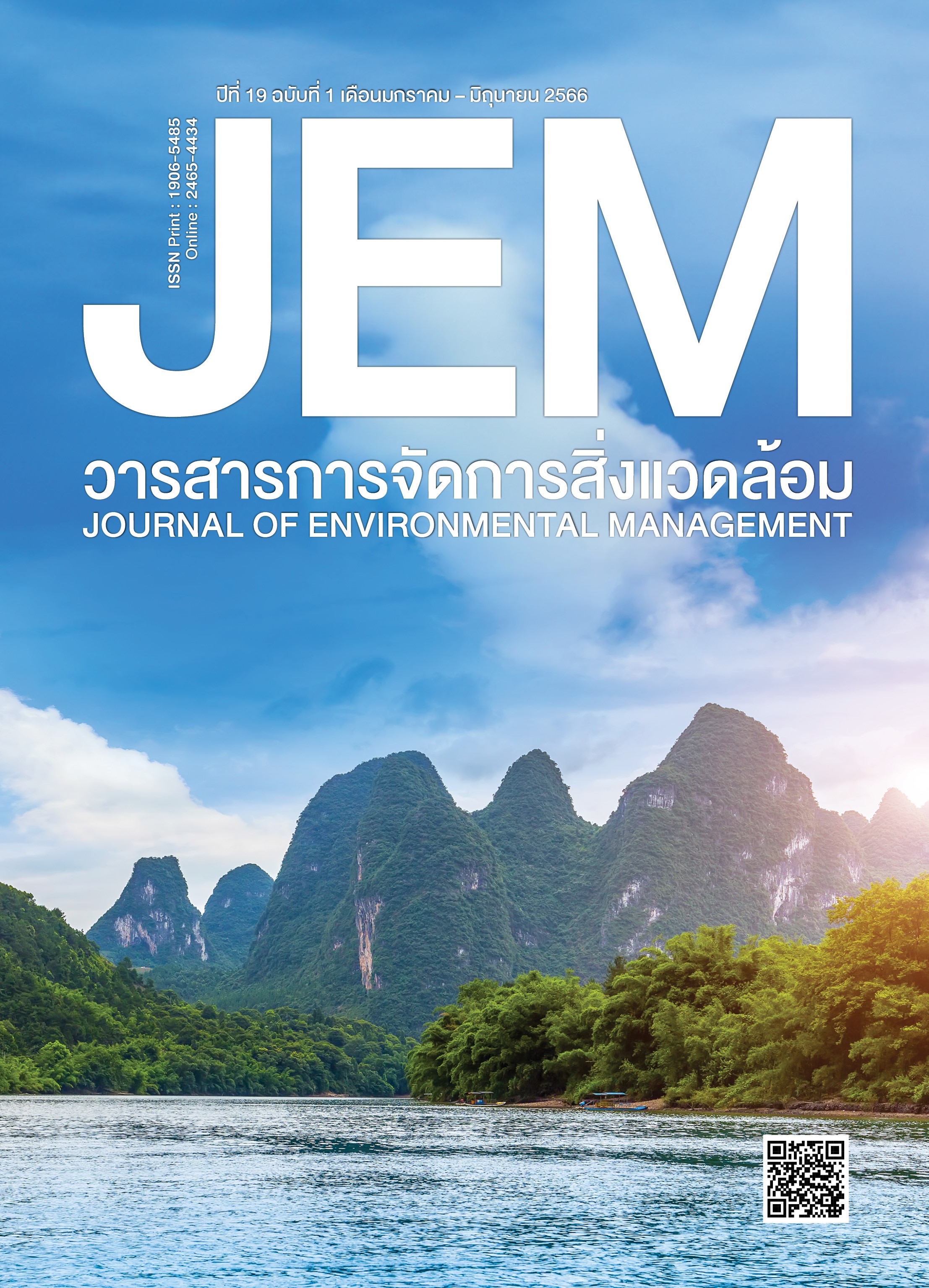การจัดการของเสียในห่วงโซ่อุปทานการผลิตฟักทองญี่ปุ่นภายใต้หลักการเศรษฐกิจหมุนเวียน: กรณีศึกษาการปลูกบนพื้นที่สูง
DOI:
https://doi.org/10.14456/jem.2023.3คำสำคัญ:
ระบบเศรษฐกิจหมุนเวียน, ของเสียทางการเกษตร, การจัดการของเสีย, ฟักทองญี่ปุ่นบทคัดย่อ
การศึกษาการจัดการของเสียในห่วงโซ่อุปทานฟักทองญี่ปุ่นนี้ ครอบคลุมตั้งแต่การปลูกไปจนถึงการแปรรูปเพื่อจำหน่ายเนื้อฟักทอง มีวัตถุประสงค์เพื่อศึกษาปริมาณของเสียทางการเกษตร และวิธีการจัดการของเสียที่เกิดขึ้น โดยเป็นงานวิจัยเชิงปริมาณใช้ข้อมูลจากการสัมภาษณ์เชิงลึกจากกลุ่มตัวอย่างของเกษตรกร และผู้มีส่วนเกี่ยวข้องจำนวน 20 ราย ในเดือนมิถุนายน - กรกฎาคม และเดือนพฤศจิกายน ปีพ.ศ.2562 โดยของเสียที่เกิดขึ้นมีหลายประเภท อาทิ ยอด-ใบอ่อน, ผลอ่อน, ผลฟักทองตกเกรด, เถา, เปลือกฟักทอง และเมล็ด โดยมีปริมาณสูงถึง 1,600 ตัน/ปี จากการเพาะปลูก 324,000 ต้น/ปี ในอำเภอแม่แตง จังหวัดเชียงใหม่ ผลการศึกษาพบว่าของเสียประเภทใดที่สามารถแปรรูปได้ง่ายควรส่งเสริมให้เกษตรกรรายย่อยดำเนินการเอง อาทิ การนำเถาฟักทองญี่ปุ่นมาผลิตเป็นถ่านไบโอชาร์ และของเสียที่จำเป็นต้องมีการลงทุน และใช้เทคโนโลยีควรดำเนินการโดยการจัดตั้งเป็นวิสาหกิจชุมชน อาทิ การนำเมล็ดฟักทองมาผลิตเป็นน้ำมันสกัด ซึ่งข้อเสนอแนะนี้ทำให้เกิดประโยชน์ทั้งมิติการลดของเสีย และการเพิ่มมูลค่าทางเศรษฐกิจให้ผู้เกี่ยวข้องโดยเฉพาะเกษตรกร และชุมชนในโซ่คุณค่าของฟักทองญี่ปุ่น ในขณะเดียวกันเกษตรกรควรจัดการของเสียที่สามารถส่งผลกระทบต่อสิ่งแวดล้อมให้ดียิ่งขึ้น อาทิ การเผาทำลายต้นฟักทองญี่ปุ่นที่ติดโรค เพื่อป้องกันความเสียหายที่เกิดขึ้นต่อแปลงเพาะปลูกในอนาคต
เอกสารอ้างอิง
Borompichaichartkul, C. (2012). Hybrid drying technology: Application for preservation of heat sensitive food products [In Thai]. KMUTT Research and Development Journal, 32(2), 271 -282.
Ciurzyńska, A., & Lenart, A. (2011). Freeze drying application in food processing and biotechnology– A review. Polish Journal of Food and Nutrition Sciences, 61(3), 165 – 170.
Department of Agriculture. (2016). Powdery mildew disease [In Thai]. Retrieved June 20, 2022,from http://microorganism.expertdoa.com/disease_7- powdery mildew.php.
Department of Primary Industries and Mines. (2021). Circular economy performance assessment guidebook [In Thai]. Retrieved June 6, 2022, from http://cepas.dpim.go.th/
Dirim, S. N., & Çalışkan, G. (2012). Determination of the effect of freeze-drying process on the production of pumpkin (Cucurbita Moschata) puree powder and the powder properties. Gıda Teknolojisi Derneğ i (GIDA), 37, 1 – 7.
Ellen MacArthur Foundation. (2013). Towards the circular economy vol. 1. Retrieved June 6, 2022, from https://ellenmacarthurfoundation.org/publications.
Food and Agriculture Organization of the United Nations (FAO). (2021). How to mainstream sustainability and circularity into the bioeconomy? Rome, Italy: FAO.
Food and Agriculture Organization of the United Nations (FAO). (2019). The state of food and agriculture 2019. Rome, Italy: FAO.
Jensen, J. P. (2018). Narrowing slowing and closing the resource loops circular economy in the wind industry (Ph.D. Thesis). Denmark: Aalborg University.
Katan, J. (2010). Cultural approaches for disease management: Present status and future prospects. Journal of Plant Pathology, 92(4), 7 – 9.
Kerdmongkol, B., Yooprasert, B. & Tangwiwat, P. (2013). The straw and rice stubble incorporation of farmers in Takhu sub-district, Pakthongchai district, Nakhon Ratchasima province [In Thai]. Nakhon Pathom: The 10th Nationnal Kasetsart University Kamphaeng Saen Conference.
Lestari, B., & Meiyanto, E. (2018). A review: The emerging nutraceutical potential of pumpkin seeds. Journal of Cancer Chemoprevention, 9(2), 92 - 98.
Li, Y., Gu, Y., Li, J., Xu, M., Wei, Q., & Wang, Y. (2015). Biocontrol agent bacillus amyloliquefaciens LJ02 induces systemic resistance against cucurbits powdery mildew. Frontiers in Microbiology, 6, 1 – 13.
Lima, P. M., Dacanal, G. C., Pinho, L. S., P´erez-C´ordoba, L. J., Thomazini, M., Moraes, I. C. F., & Favaro Trindade, C. S. (2021). Production of a rich-carotenoid colorant from pumpkin peels using oil-in- water emulsion followed by spray drying. Food Research International,146, 1 – 8.
Ministry of Agriculture, Animal Industry and Fisheries. (2015). Food and nutrition handbook for extension workers. Retrieved June 6, 2022, from http://pdf.usaid.gov/pdf_docs/PA00TBCT.pdf.
Mueangklang, K., Rakdanklang, N., Dongkrathok, N., Chanthinok, T., & Chidkarn, T. (2021). Natural recycled materials diecasting machine [In Thai]. Industrial Technology Journal, 6(2),65 – 67.
National Research Council of Thailand. (2015). Development of hard tofu from pumpkin seeds [In Thai]. Bangkok: Thailand Research Symposium 2015.
Ogori, A. F., Joeguluba, O., Onyocha, A. O. U., Tanko, S., Apeh, M. E., & Abigail, Y. (2015). Effects of processed fluted pumpkin vegetables leaves (Ugu) on certain meals in Kontagora, Nigeria. Direct Research Journal of Agriculture and Food Science (DRJAFS), 3(6), 138 – 142.
Onu, P., & Mbohwa, C. (2021). Agricultural waste diversity and sustainability issues: Sub-Saharan Africa as a case study. Retrieved June 6, 2021, from https://doi.org/10.1016/B978-0-323-85402-3.00006-1
Rattanawan, N., & Intaruccomporn, W. (2018). Knowledge and practices of correctly using chemicals of japanese pumpkin growers, Mon-Ngoe royal development project, Mae Taeng district, Chiang Mai [In Thai]. Journal of Agricultural Research and Extension, 35(1), 55–65.
Roidoung, S., Singkhan, P., & Pinkum, N. (2018). Development of frozen pumpkin flour tart [In Thai]. Agricultural Sci. Journal, 49(3), 248–251.
Sastsara, S., & Mekdee, K. (2021). Accessing funding and problems of community enterprise entrepreneurs in Phra Nakhon Si Ayutthaya province [In Thai]. Journal of Educational Review Facultyof Educational in MCU, 8(3), 300 – 302.
Sawangpanyangkura, T. (2015). Compost by engineering, Maejo university 1 [In Thai], Retrieved July 4, 2022, from https://engineer.mju.ac.th/wtms_webpageDetail.aspx?wID=1258.
Sinthao, N., Thongpartee, P., & Dokmaijeen, W. (2019). Banana sheath bowl (Bachelor’s project) [In Thai]. Bangkok: Siam University.
Srisamatthakarn, P., Ammawath, W., Cham, C., Kanobdee, J. and Na Nan, P. (2019). Antioxidant food innovation from high oilseed pumpkin (Cucurbita spp.) (Research reports) [In Thai]. Chiang Mai: Rajamangala University of Technology Lanna.
Suwanaruang, T. (2017). Total carotenoid content in fresh vegetables [In Thai]. Rajabhat Agric, 16(2), 40 – 45.
The Office of the Board of Investment. (2019). The new economic solution. Thailand Investment Review (TIR), 29(1), 3 – 4.
Wongsiriamnuay, T. (2022). Biochar [In Thai]. Retrieved July 5, 2022, from https://erp.mju.ac.th/acticleDetail.aspx?qid=1072.



